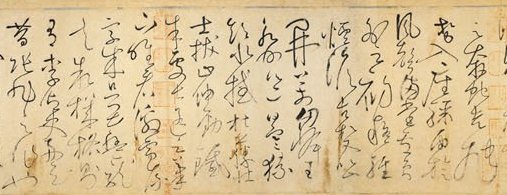
Theories of Chinese Calligraphy
Though
diligent
and consistent practice is very
important to an artist, understanding, insights and reading
literatures are also
important. Chinese used to call a man who has calligraphy skills yet
without enough knowledge or depth a “calligraphy artisan” rather than a calligrapher.
Knowing the historical background and life experiences of ancient calligraphers
will give us better understanding and hints for practicing Chinese
calligraphy.
A.
Tsao Shu Posture 草
書
勢: Tsui Yuan (77-142)
of the Han Dynasty
“…
Trying to examine the structure and posture of a Tsao Shu character, whether
it’s tall, low, up or down, it obeys strict methodology. So don’t assume
that they don’t fit into rules. Some characters look slanted, with left side
low and right side high. These resemble beasts lifting heads before running, or birds cheering up before flying. It also looks like a frighten rabbit running
but not started yet …”
“The
writing of Tsao Shu with precipitous structure looked far away like a falling
clip by the river; however its strokes are undetachable when examined close by.
The delicacy and nuances within this wonder is …”
Note: An insightful artist who does not know the Chinese language may think
those descriptions were exaggerating when s/he is reading those excerpts and
appreciating some Chinese calligraphy works commonly seen in public medias. It
depends on what Chinese calligraphy work
you have seen. Those we have seen at Wang
Hsi-Chih’s time were almost duplicates by the Tang Dynasty calligraphers
and the level of art had gone down quite a lot – spirit changed, appearance
not quite the same … Those calligraphers before him almost left no works on
original paper. (Some call these the "ink on paper" versions.) The works we see today have been duplicated many, many times
throughout each dynasty. Of course, the spirit was lost forever on tablets and
cannot show the ink nuances of the original calligraphy.
Furthermore, the pictures of rubbings of ancient Chinese calligraphy works are
usually lower quality scans without enough pixels in many books or web sites.
B.
Zuan Shu Postures 篆
書
勢:
Tsai Yong (132-192) of the Han Dynasty
“
… Some strokes are very light with some turning, and the ink nuances are
different at the start and end of a stroke. It’s so well connected that it
looks like dew traveling alongside a silk thread and gathering at its end.”
“
… This kind of Zuan Shu looks like a group of flying bird far away. When we
approach for a better look, we cannot tell how each stroke and character started
as if it came from nowhere.”
C.
Map
of Strokes Disposition "Bi Zhen Tu 筆
陣
圖"
:
Madame
Wei (272-349) of the Jin Dynasty
“
When the prime mister Lee Si
witnessed Zhou Mu Wang’s writing, he kept praising for seven days but thought
it lacked backbones.”
D.
Talking About Calligraphy: Wang Sen-Chian
(王
僧
虔,
426-485) of the South Chi Dynasty
“Tsai
Yong did not want to write unless it’s a very delicate silk or cloth…”
E. Article on Zhong Yao's Calligraphy: Emperor Wu Di (464-549) of the Liang Dynasty
“When
Wang Hsi-Chih emulated Zhong Yao’s work, the posture of each character was
delicate and detailed. However, when he practiced alone from memory, the level
of each character just went down.”
“Wang
Hsian-Chih was not as good as Wang Hsi-Chih just as Wang Hsi-Chih was not as
good as Zhong Yao. Learning Wang Hsian-Chih’s work is like painting a tiger;
learning Zhong Yao’s work is like painting a dragon.”
F.
Talking about Wang Hsi-Chih: Emperor Tang Tai Zong
“I
examined all calligraphy works with tiny details of ink from ancient times until
now. I only find Wang Hsi-Chih
as the most perfect calligrapher … His works look like mist surrounding, dews
condensing, connecting as if not connecting … upright as if slanted.”
G.
Autobiography
自
序
帖:
Huai Su (725-785) of the Tang Dynasty
“… to describe the shape of a Tsao character… It looked like light smoke around an ancient pine tree, but suddenly it opened up like a high cliff of 10,000 yards…I only see lightings and electricity twinkling under the brush. Once the work was finished even a crouching dragon will fly away.“
(Click for complete picture)
H.
Biography of Huai Su 懷
素
傳:
Lu Yu of the Tang Dynasty. (Lu Yu wrote three
rolls of scriptures about
tea tasting and was
referred to as
the “god of tea.”)
“Wuu
Dan told Huai Su, “There are many styles of Tsao Shu. Because Wang
Hsian-Chih’s Tsao Shu looks like leafless, stiff, and dry trees in the winter,
Tang Tai Zong did not like it. Zhang Shui (
張
旭
) had told me in private
that the lively postures and movements
of Tsao Shu writing
resemble a scene of a high tent with flying sand blown up from nowhere
…“”
I.
Biography of Liu Gong-Chuan 柳
公
權
傳
“…
Emperor Tang Mu Zong sometimes
was odd in running government affairs.
Once
he asked Liu Gong-Chuan about the perfect way to hold a brush. Liu replied,
“Operating the brush is from the heart. If the heart is upright, then the
brush will be upright.” As the emperor realized his hint, he felt sorry …”